Illinois was both cooler and drier than the 1991–2020 normal in 2022. The statewide average annual temperature was 52.0 degrees, 0.6 degrees below normal and tied for the 51st warmest on record. Statewide average total precipitation in 2022 was 37.24 inches, 3.51 inches below normal and the 61st driest year on record.
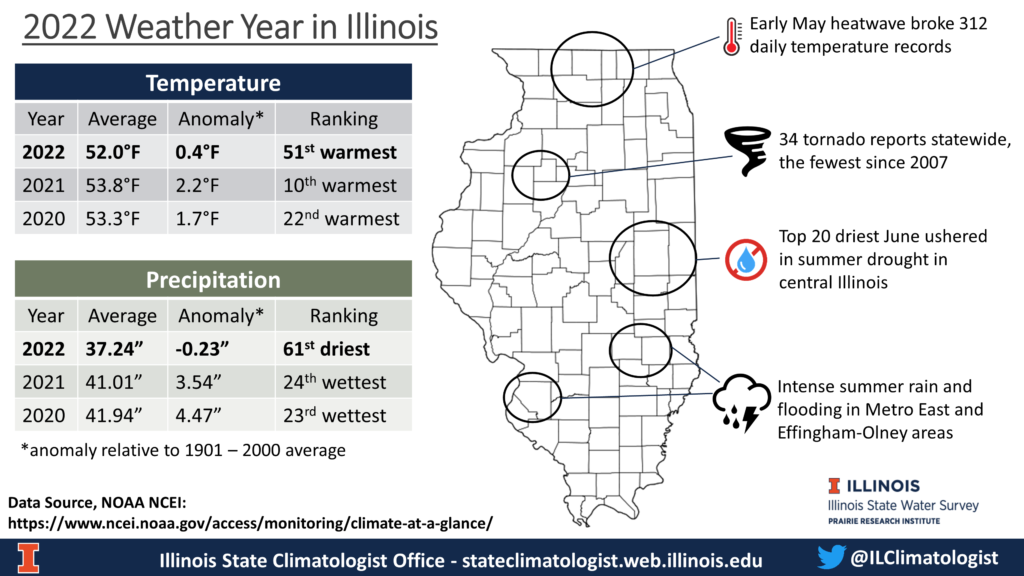
2022 Temperatures
Following the second warmest December on record statewide, temperatures moderated quite a bit to start 2022. January and February average temperatures were 4.5 degrees and 3.2 degrees below the 1991–2020 normals, respectively. Spring was a mixed bag, with a very warm March and May split by an April that was nearly 3 degrees colder than normal. A hot start to summer pushed June 1.3 degrees above normal statewide, while July was only 0.3 degrees warmer than normal and August’s average temperature equaled the normal. Fall was very pleasant, as September and November were both just slightly warmer than normal, while October was 1.3 degrees colder than normal statewide. A December full of wild temperature swings ended just over 1 degree colder than normal to cap off 2022.
Overall, the statewide average annual temperature was 52.0 degrees, 0.6 degrees below normal (Figure 1). However, because Illinois has experienced a 100+ year warming trend as part of human-caused climate change, the statewide average annual temperature was still 0.4 degrees above the 20th century average, and 2022 tied for the 51st warmest on record statewide.
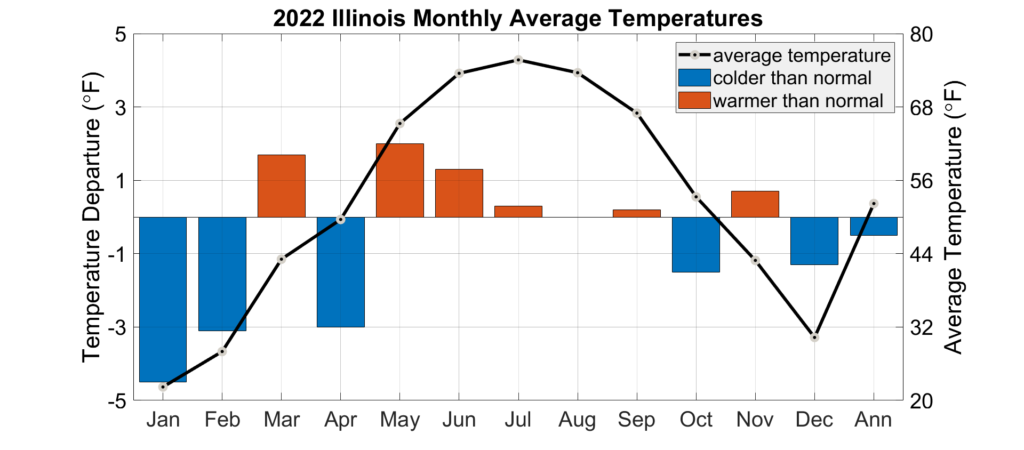
Figure 2 shows 2022 average temperatures and departures from normal across the state. Average temperatures ranged from the low 40s in northern Illinois to the low 50s in southern Illinois. Most of the state was within 1 degree of the 30-year normal, while part of western Illinois was between 1 and 2 degrees colder than normal in 2022.
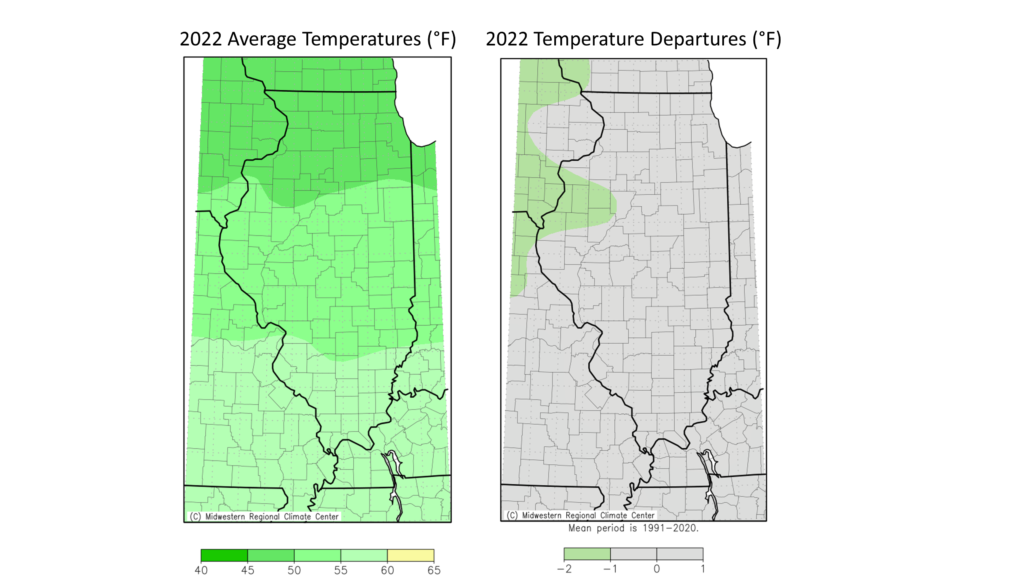
The year 2022 was the 34th warmest on record in Chicago, 27th warmest on record in St. Louis, 45th warmest on record in Peoria, 50th warmest on record in Rockford, and 48th warmest on record in Moline. The year was also the 60th coolest on record in Springfield, 52nd coolest on record in Quincy, and 39th coolest on record in Carbondale. Bean Ridge in Alexander County was the warmest point in the state in 2022 with an average temperature of 59.5 degrees. Elizabeth in Jo Daviess County was the coldest point in the state last year with an average temperature of 46.6 degrees.
Table 1 shows the number of daily weather records broken at Illinois Cooperative Observer stations in each month of 2022. May led with the highest number of high daily maximum and high daily minimum temperature records, with over 150 of each. Three stations in Illinois broke their all-time May high maximum temperature records in 2022, including a 96-degree high in Rock Island and a 99-degree high in Chenoa. Eleven stations also broke their all-time May high minimum temperature records in 2022, including an 80-degree low temperature in Rock Island and a 74-degree low in Peoria.
The heatwave that broke so many daily weather records across Illinois was remarkable in many ways. First, it occurred in the first half of May, while most May temperature records are set in the latter half of the month. The heat itself was extreme with most places in the state experiencing multiple days with high temperatures in the mid- to upper 90s. Lastly, the heat arrived very quickly and followed a prolonged period of cooler weather in April and early May. A rapid change from cool to hot weather, especially early in the warm season, is associated with an elevated risk of heat-related health impacts.
The Excess Heat Factor (EHF) is a metric used to account for the intensity of a heat wave and how well an area was acclimated (or not acclimated) to the heat ahead of the heat wave. Figure 3 shows all heat waves on record in Rockford, expressed as their EHF value, with higher values indicating more extreme heat waves. Because of its intensity in absolute temperature and compared to the prior cool period in April, the May 2022 heat wave had the highest EHF value of any heat wave on record in Rockford.
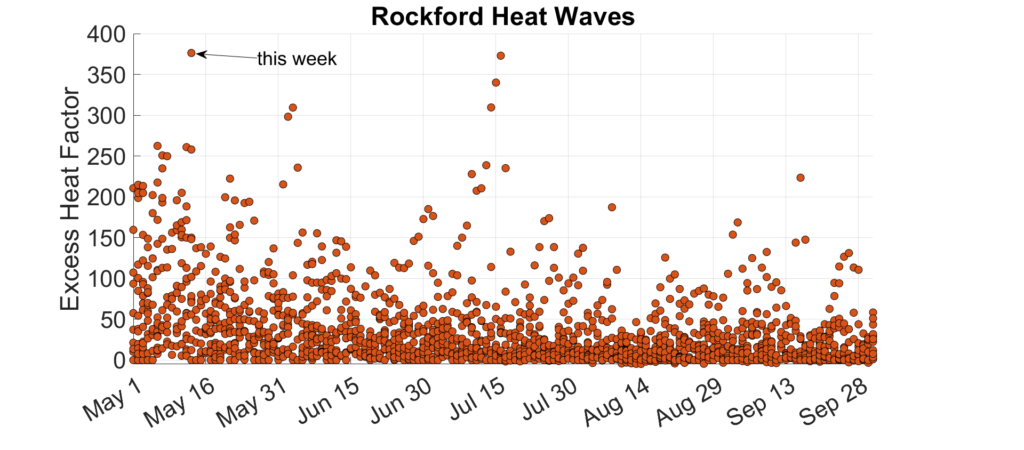
Milder temperatures in April, October, and November also resulted in dozens of low maximum and low minimum temperature records broken across the state in 2022. However, three times as many high maximum or high minimum temperature records (791) were broken last year in Illinois as low maximum or low minimum temperature records (247).

There were also 538 daily total precipitation records broken across Illinois in 2022. Daily precipitation records broken were somewhat equally spread among months, but July led with 90 records.
2022 Precipitation
Calendar year 2022 began with a very dry January, with less than 50 percent of normal precipitation statewide. February and March were 1.04 inches and 1.42 inches wetter than normal, respectively, making for wet soils heading into the spring. While April was slightly drier than normal statewide, many places in the state had a double-digit number of days with measurable rain. Macomb, for example, had 25 out of 30 April days with measurable rainfall, but was still drier than normal for the month. May was slightly drier than normal, and June was nearly 2 inches drier than normal statewide. Meanwhile, July and August were both wetter than normal, followed by all three fall months with below normal precipitation. December wrapped up 2022 just slightly drier than normal statewide (Figure 4).
Overall, statewide average total precipitation in 2022 was 37.24 inches, 3.51 inches below normal and the 61st driest year on record.
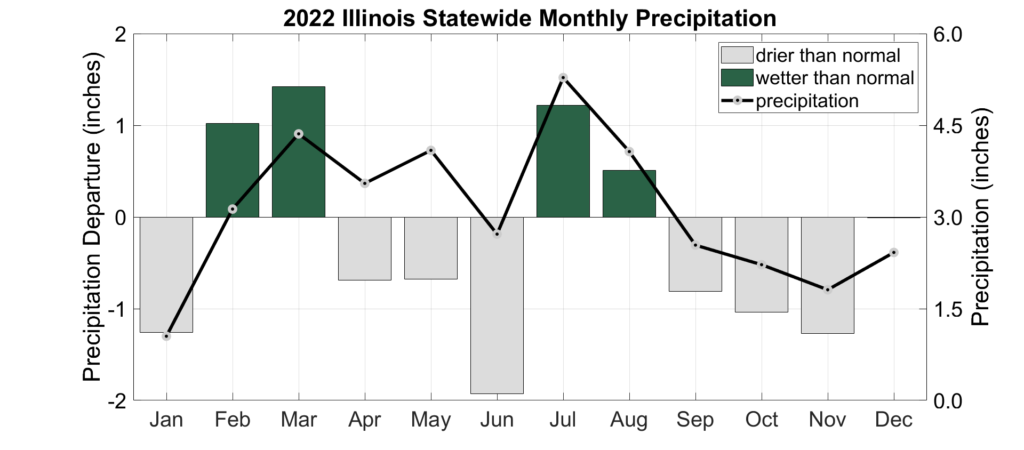
Much like past years, the statewide preciptiation statistics are not representative of all places in Illinois. Calendar year 2022 was somewhat to much drier than normal in most of central and southern Illinois, but wetter than normal in areas that experienced extreme rainfall, such as the St. Louis Metro East and far northern Illinois. Last year was the 14th driest on record in Mt Vernon, the 50th driest on record in Champaign, and the 41st driest on record in Moline; however, it was also the 30th wettest on record in Edwardsville and the 9th wettest on record in Freeport.
Figure 5 shows the spatial variability of 2022 precipitation in more detail. Total precipitation in 2022 ranged from nearly 50 inches in far southern Illinois to less than 35 inches across much of north-central Illinois. Large parts of far nothern and south-central Illinois were 1 to 5 inches wetter than normal last year, while much of central and far southern Illinois were 1 to 8 inches drier than normal.
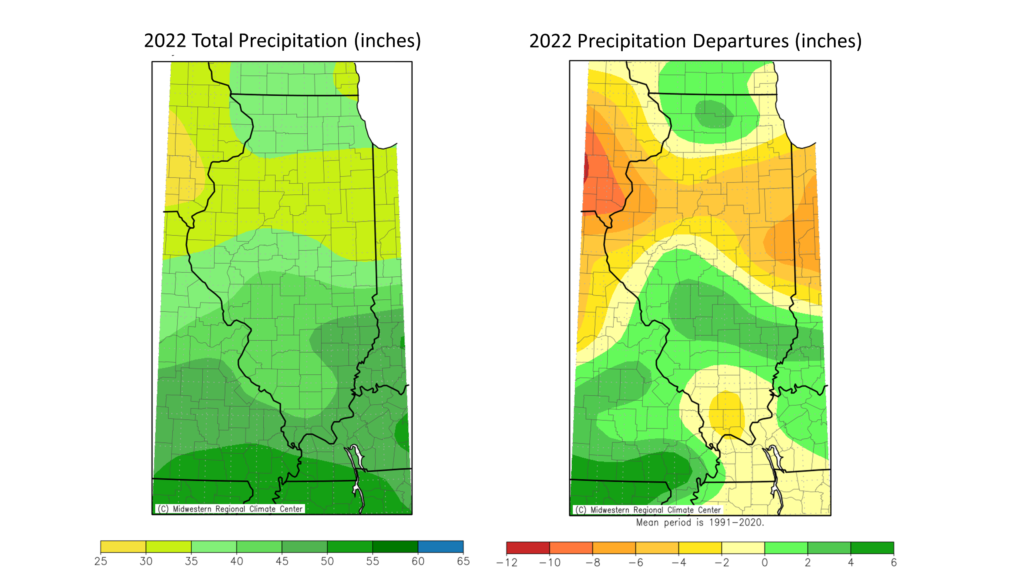
The long-term Cooperative Observer station in Effingham recorded 56 inches of precipitation in 2022, making Effingham the wettest point in the state last year. Meanwhile, CoCoRaHS citizen science observers in LeRoy in McLean County and Mansfield in Champaign County recorded just 26 inches of precipitation in 2022. The year 2022 was the 21st driest on record in Peoria with just 28.75 inches (76 percent of normal).
2022 Severe Weather
Last year was a mixed bag for severe weather. Most of our 102 counties were affected by strong wind, hail, or tornado events last year (Figure 6). Overall, the NOAA Storm Prediction Center showed 34 tornado reports, 104 hail reports, and 535 wind reports statewide in 2022. The 34 tornado reports in 2022 were well less than the 80 reports noted in 2021 and were the fewest tornado reports in Illinois since 2007.

Extreme precipitation and resultant flooding have become a mainstay in Illinois. Last year brought several very heavy precipitation events across the state. Among these events was a series of storms in the St. Louis area on July 26, producing several inches of rain in just a few hours. Parts of Cahokia Heights and Belleville caught 7 to 8 inches of rain in less than eight hours, causing widespread flooding (Figure 7). Based on state estimates of rainfall intensity probabilities, these totals in the Belleville area exceeded the estimated 0.2 percent annual exceedance, meaning this type of event has a 0.2% chance of occurring in any given year (https://www.weather.gov/lsx/July262022Flooding).
Just two weeks later, a swath of east-southeast Illinois between Effingham and Olney saw 7 to 10 inches of rain in less than 24 hours. The intense rainfall, centered over Newton in Jasper County, caused widespread flooding in nearly mature corn and soybean fields and riverine flooding along the Little Wabash and Embarras Rivers. Days later, a series of strong storms produced up to 11 inches of rain in less than 48 hours in parts of Jo Daviess and Stephenson counties in northwest Illinois. The rain inundated roads, flooded homes in and around Freeport, and caused flooding along the Pecatonica River (https://www.weather.gov/dvn/summary_080822).
Overall, 2022 brought its own set of unique conditions and weather. Despite daily and monthly variability in temperature and precipitation, most of the state was a bit cooler and drier than the 1991-2020 normal last year.

